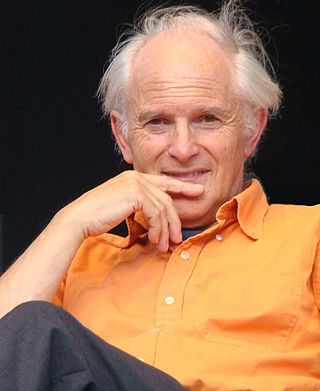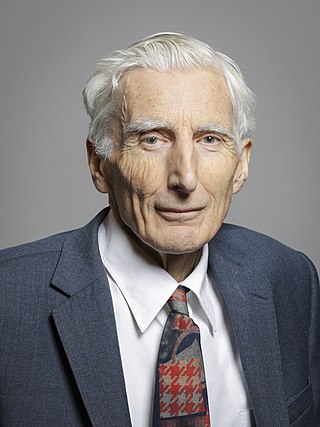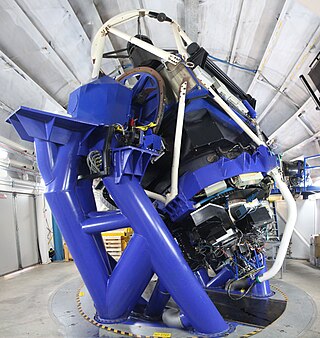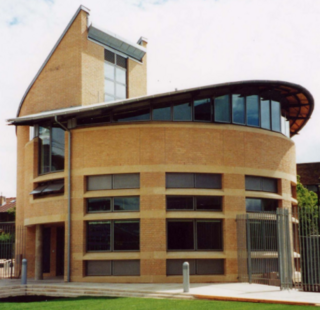
Sir Harold Walter Kroto was an English chemist. He shared the 1996 Nobel Prize in Chemistry with Robert Curl and Richard Smalley for their discovery of fullerenes. He was the recipient of many other honors and awards.

Edward Arthur Milne FRS was a British astrophysicist and mathematician.

Martin John Rees, Baron Rees of Ludlow, is a British cosmologist and astrophysicist. He is the fifteenth Astronomer Royal, appointed in 1995, and was Master of Trinity College, Cambridge, from 2004 to 2012 and President of the Royal Society between 2005 and 2010.

The University of Hull is a public research university in Kingston upon Hull, a city in the East Riding of Yorkshire, England. It was founded in 1927 as University College Hull. The main university campus is located in Hull and is home to the Hull York Medical School, a joint initiative with the University of York. Students are served by Hull University Union.

John David Barrow was an English cosmologist, theoretical physicist, and mathematician. He served as Gresham Professor of Geometry at Gresham College from 2008 to 2011. Barrow was also a writer of popular science and an amateur playwright.

Siding Spring Observatory near Coonabarabran, New South Wales, Australia, part of the Research School of Astronomy & Astrophysics (RSAA) at the Australian National University (ANU), incorporates the Anglo-Australian Telescope along with a collection of other telescopes owned by the Australian National University, the University of New South Wales, and other institutions. The observatory is situated 1,165 metres (3,822 ft) above sea level in the Warrumbungle National Park on Mount Woorat, also known as Siding Spring Mountain. Siding Spring Observatory is owned by the Australian National University (ANU) and is part of the Mount Stromlo and Siding Spring Observatories research school.

The Faulkes Telescope South is a clone of the Liverpool Telescope and is located at Siding Spring Observatory in New South Wales, Australia. It is a 2 m (79 in) Ritchey-Chrétien telescope. It was designed to be operated remotely with the aim of encouraging an interest in science by young people. It is supported by an altazimuth mount.

Professor Anneila Isabel Sargent FRSE DSc is a Scottish–American astronomer who specializes in star formation.

Dame Frances Clare Kirwan, is a British mathematician, currently Savilian Professor of Geometry at the University of Oxford. Her fields of specialisation are algebraic and symplectic geometry.
The Faulkes Telescope Project (FTP) is supported by the Dill Faulkes Educational Trust. It provides access to 1,500 hours of observing time on two 2-metre class telescopes located in Hawaii and Australia. This time is dedicated to education and public outreach, mainly in the UK, but also for smaller, selected projects in Europe and the US.
RoboNet-1.0 was a prototype global network of UK-built 2-metre robotic telescopes, the largest of their kind in the world, comprising the Liverpool Telescope on La Palma, the Faulkes Telescope North on Maui (Hawaii), and the Faulkes Telescope South in Australia, managed by a consortium of ten UK universities under the lead of Liverpool John Moores University. For the technological aims of integrating a global network to act effectively as a single instrument, and maximizing the scientific return by applying the newest developments in e-Science, RoboNet adopted the intelligent-agent architecture devised and maintained by the eSTAR project.

Sir Kenneth Aphunezi Olisa is a British businessman and philanthropist. He is the first mixed heritage Lord-Lieutenant of Greater London. He founded and led the AIM-listed technology merchant bank Interregnum and now leads Restoration Partners. Ken Olisa is Past Master of the Worshipful Company of Information Technologists and has served and serves on several boards of philanthropic, educational and regulator organisations. Sir Kenneth with his wife endowed the Olisa Library at Fitzwilliam College, Cambridge.
The Philip Leverhulme Prize is awarded by the Leverhulme Trust to recognise the achievement of outstanding researchers whose work has already attracted international recognition and whose future career is exceptionally promising. The prize scheme makes up to thirty awards of £100,000 a year, across a range of academic disciplines.
Professor Nigel Peter Weatherill, BSc, PhD, DSc, FIMA, C.Math, FRAeS, C.Eng, C.Sci, FREng, FRSA, DL is the former Vice-Chancellor and Chief Executive of Liverpool John Moores University (2011-2018).

The Astrophysics Research Institute (ARI) is an astronomy and astrophysics research institute in Merseyside, UK. Formed in 1992, it stood on the Twelve Quays site in Birkenhead from 1998 until June 2013 when it relocated to the Liverpool Science Park in Liverpool. It is in the top 1% of institutions in the field of space science as measured by total citations.

George Cunliffe McVittie (1904–1988) was a British mathematician and cosmologist. He is best known for his contributions towards radio astronomy.

The Newton Gateway to Mathematics, formerly known as the Turing Gateway to Mathematics (TGM), is a research intermediary at the Isaac Newton Institute for Mathematical Sciences (INI) between the users of mathematics and those focused on research. It is also supported by the University of Cambridge. It regularly hosts events that focus on the discussion and exploration of mathematical techniques and models.
Teresa Mary Anderson is a British physicist and the director of the University of Manchester's Discovery Centre at Jodrell Bank Observatory. She is a professor at the University of Manchester and the curator of science at the Bluedot Festival.

Brad Gibson is a retired Australian-Canadian astrophysicist. He is known for identifying the regions of the Galaxy most likely to harbor complex biological life, designing and constructing the first operational liquid mirror telescope observatory, and using supernovae as cosmological probes, the latter for which led to the 2009 Gruber Prize in Cosmology. A passionate advocate for Widening Participation, Gibson delivers more than 100 presentations annually to schools and the general public; his Changing Face of Physics campaign was highlighted as Good Practice by the UK Equality Challenge Unit.














